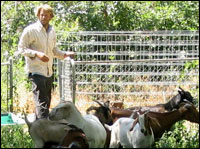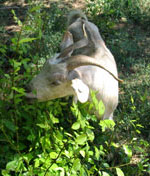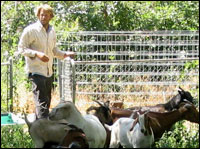The lawnmower was broken. Not that I knew how to use it, anyway, as I’d spent my whole life until a year ago in lawn-less New York City. Now, though, I was in Boulder, Colo., with waist-high weeds in my yard. I refused to even consider herbicides, but my attempt to pull the weeds by hand proved futile: After several hours, all I had to show was one small patch of bare turf and an aching back.
The weeds didn’t bother my boyfriend, who reasoned that it was all just leafy green stuff and therefore natural and therefore good — demonstrating, as the saying sort of goes, that one woman’s weed is another man’s wildflower. But, though some of the weeds were beautiful, I knew enough about gardening to understand that sometimes you have to be ruthless. So I did what any environmentally conscious, recently transplanted city girl would do: I hired a herd of goats.

Guggenhime sowing his wild goats.
Photo: Hillary Rosner.
The goats belong to Jim Guggenhime, who is 27 years old, blond, good-looking, and exactly as laidback as you’d expect a professional goatherd to be. Before college, Guggenhime traveled and taught in East Africa, where he developed a fondness for goats. After graduating from the University of Colorado, he amassed a small herd. He soon decided he wanted to turn the goats into his livelihood, but raising goats exclusively for meat was too difficult and too brutal. (Guggenhime is troubled by his love for both the animals — “they all have such personalities and they’re really cute” — and their meat — “it just tastes so good.”) Recognizing goats’ other profitable asset, Guggenhime opened a grazing business this summer called Nip It in the Bud. His herd of approximately 200 now travels the region helping to keep the ecosystem in balance.
Using goats to battle weeds is gaining popularity in the West, where noxious and invasive plant species are pervasive and poor management has left a lot of land in bad shape. A company in California, Goats R Us, has been using goats to keep weeds in check since 1995. In the inland West, the grand dame of goat-herding is Lani Malmberg, whose herd of 1,200 has no home base but goes from one job to the next, migrating from Colorado to Wyoming to Idaho and beyond. Malmberg, who holds a master’s degree in weed science, helped Guggenhime start his company and sold him some of her goats.
“There’s a lot of awareness now of what chemicals do to the environment,” says Malmberg, who believes we are on the cusp of an “age of environmentalism,” current federal government policies notwithstanding. “Plus, they’ve been using chemicals against weeds for 45 years, so there shouldn’t be a weed on this planet. Obviously it’s not working and they’re looking for something else, a logical way to slowly heal the land.”

A leafy lunch.
Photo: Hillary Rosner.
Enter the goats. Technically, goats don’t graze; they browse. They’ll eat brush, leaves, twigs, and other such food first, only turning to grass when there’s nothing else left. Goats also don’t munch each plant down to a nub and move on. They’ll pick off the flower heads so the plant can’t go to seed, and eat the leaves so it can’t photosynthesize. But they’ll leave the stalk, which holds the soil in place, preventing erosion. With only a bare stem left, the plant has to work overtime just to stay alive, giving native or more desirable plants a chance to grow. Goats also poop a lot, and as they roam, their tough hooves stomp the pellets into the soil, fertilizing and helping to soften Colorado’s hard clay. They also irrigate, a pint at a time, with nitrogen-tinged urine that helps balance the minerals in the soil. And, notably, they’ll eat just about anything, including plants that are poisonous to other animals.
No Good Weed Goes Unpunished
Using biocontrols (such as goats) instead of chemicals is a practice that has grown alongside organic farming, but it has yet to really explode into the mainstream. “A lot of it is force of habit,” says Chad Brunette, senior horticulturalist at the Denver Botanic Gardens, who believes the goats are also a useful public relations tool. “Most people who have a huge weed problem would just spray Roundup. People are too busy to think sometimes.”
Brunette, who spent several years working with organic farmers, says his favorite biocontrol was a mobile chicken coop in Michigan. “This one old guy had a chicken coop on wheels that he would cart around to his fruit trees, and anywhere there were insects he would park that coop. He saved money on seed for the birds and the fruit trees suffered less damage.”

A push in the right direction.
Even outside the world of organic farming, biocontrols and other environmentally friendly weed-control techniques are beginning to take root in the collective consciousness. From old-school push lawn mowers to carefully cultivated insects, alternatives to harmful herbicides and polluting weed whackers are becoming more readily available as awareness of sustainable gardening grows.
“We’re asking, ‘What is the true cost?'” says Malmberg, considering the impact on the planet of spraying toxic chemicals versus running goats or using other eco-conscious methods to wipe out weeds. “It’s a slow change. We’re on the crest of it but it is in motion.”
Push mowers, which run on elbow grease rather than gas or electricity, are for sale at most garden centers and Home Depots. Organically inclined home gardeners can find chemical-free herbicide recipes on the Internet that use vinegar and other ingredients commonly found in kitchens, or they can buy readymade versions at eco-friendly gardening supply stores. And in the future, intrepid weed-battlers may be able to purchase insects specially matched to specific invasive plants. Along the eastern edge of the Rockies in Colorado’s Front Range, a University of Colorado professor has been successfully using several types of beetles to combat diffuse knapweed, a noxious invasive species that has infested more than 3 million acres across the West.
But insects are targeted at specific species; what I had in my yard was a more generalized mess that clearly called for goats.
Herd It Through the Grapevine
I decided to check out Guggenhime’s herd in action before I hired them. Goats are generally used on areas considerably larger than my 2,000-square-foot yard, and in more rural areas — county land at the edges of towns or sprawling private ranches. When I caught up with Guggenhime, his crew was grazing at the Mount Vernon Country Club near Golden, Colo. on 1,100 acres of pasture overgrown with poison hemlock, Canadian thistle, musk thistle, and spurge. It was tough to imagine the pasture being restored to prairie grass, but the herd seemed to be making progress. In sections of the pasture, clusters of denuded stalks stuck out from the landscape.

The goats get down to business.
Photo: Hillary Rosner.
“We tried chemicals, beetles, hand-pulling,” said Dave Harrison, a Mount Vernon homeowner who was throwing down pea and clover seed in the pasture. “Goats are by far the most efficient.” Guggenhime typically charges $1 per day per goat, plus transportation and fencing costs, which makes the goats an economical alternative as well.
Guggenhime agreed to dispatch a crew of 32 to my urban yard as a test run, to see if the small-scale weeding venture could be profitable. First, though, he sent a colleague by to fence off the sections of yard I didn’t want eaten: three rose bushes, some beds of tulips and poppies, and my city-girl-gone-green vegetable garden. (The ravenous nature of goats has its drawbacks: Without active management, overgrazing can be a problem. In parts of central Asia, overgrazing by goats is wiping out biodiversity and turning foothills into desert. My main concern, however, was for my broccoli.)
The next day, Guggenhime carefully maneuvered his 25-foot trailer into the alley behind my bungalow and let loose a posse of eager weed-munchers: almost three dozen nannies and kids and a few billies. The goats trotted from the trailer and through a makeshift corral into the yard, where they grouped in the corner looking disoriented. Soon enough, though, they realized they had landed in a weed buffet, and they quickly dispersed and got down to it, munching and snoozing and pooping and batting horns and saying “maaaaaaa” and munching some more. Meanwhile, Guggenhime and I seeded the yard, one-third wildflowers and two-thirds native grasses. (It’s a good idea to seed before or during a goat session, Guggenhime had told me, because they irrigate and fertilize as they till the soil with their hooves.)

Lying down on the job.
Photo: Hillary Rosner.
The first plants to get chomped were the leafy shoots of my big elm tree, some of which were several feet high and covered with delectable, bright green leaves. One goat even climbed into the tree to munch. Meanwhile, others busied themselves on a big patch of thistle, as still more went to work on a tangle of shrubbery and bindweed that had grown a foot high and more than a foot thick over our chain-link fence. “Am I dreaming, or are those goats in your yard?” asked my neighbor to the west.
When the time came to leave the goats overnight, Guggenhime turned on an electric charge in the fencing to thwart would-be escapees. When the goats are grazing on larger plots of land, he sleeps in his trailer to make sure they’re okay. But tonight he was going home to his wife and five-month-old son, Jake.
“Do you feel like you’re leaving your babies in the hands of a stranger?” I called after him as he and Nap, his Australian shepherd, hopped the electric fence and headed out into the alley.
He turned back and smiled. “I feel like I’m leaving a stranger in the hands of my babies.”
The night passed uneventfully, just a group of goats grazing in the moonlight before dozing off. I was amazed at how late they slept in the morning; I spent a full two hours drinking coffee on the deck before any of them bothered to stand up. But they deserved their sleep. The yard looked like a different place. The tangled jungle of waist-high weeds had given way to clumps of grass and soft soil. The virulent shoots that grew around the old elm tree had been obliterated. A groundcover that no one seemed able to identify had been mowed down from a foot to a couple of inches high.
In the morning, Guggenhime loaded his goats back into the trailer so they could join their comrades to help clean up county land just south of the city. Two weeks later, I’m still something of a naturalist celebrity in the neighborhood: “I saw your goats grazing by the highway!” friends keep enthusing. Here in my yard, native grass, delicate and shimmering, has begun to peek through the many lumps of residual goat poop. Stripped and browning stalks of formerly proud weeds sway weakly in the still-slightly-barnyard-tinged wind. My vacant lot has become a nascent (if fragrant) Eden. I’m going to bring the goats back in the fall.



